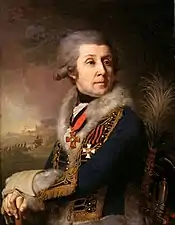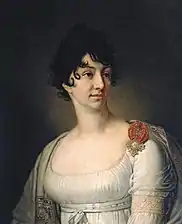Vladimir Borovikovsky
Vladimir Lukich Borovikovsky (Russian: Влади́мир Луки́ч Боровико́вский, Ukrainian: Володи́мир Лýкич Боровикóвський, Volodýmyr Lúkyč Borovykóvs’kyj; July 24 O.S. (August 4, N.S.) 1757, Mirgorod – April 6 O.S. (April 18, N.S.) 1825, St. Petersburg) was a prominent Russian Imperial painter of Ukrainian origin,[2] who served at the court of Catherine the Great and who dominated portraiture in the Russian Empire at the turn of the 19th century.
Vladimir Lukich Borovikovsky | |
|---|---|
 Portrait of Vladimir Borovikovsky by Bugaevsky-Blagodatny | |
| Born | August 4, N.S., 1757 |
| Died | April 18, N.S., 1825 St. Petersburg, Russian Empire |
| Education | Member Academy of Arts (1795)[1] |
| Alma mater | Imperial Academy of Arts[1] |
| Known for | Painter |
| Movement | Orientalist |
Biography
Vladimir Borovikovsky was born in Mirgorod,[3][4] Cossack Hetmanate, Russian Empire (now Ukraine) on July 24, 1757 in a family with Ukrainian Cossack background.[5] His father, Luka Borovik, was an icon-painter.[6] According to the family tradition, all four of Borovik's sons served as Cossacks in Mirgorod regiment, but Vladimir retired early at the rank of poruchik and devoted his life to art — mostly icon painting for local churches.
Borovikovsky lived in Mirgorod until 1788, where he painted icons and portraits in the Cossack Baroque tradition.[7] His friend Vasily Kapnist was preparing an accommodation for Empress Catherine II in Kremenchuk during her travel to newly conquered Crimea. Kapnist asked Borovikovsky to paint two allegoric paintings (Peter I of Russia and Catherine II as peasants sowing seeds and Catherine II as a Minerva) for her rooms. The paintings so pleased the Empress that she requested that the painter move to Saint Petersburg.
After September 1788 Borovikovsky lived in Saint Petersburg where he changed his surname from the Cossack Borovyk to the more aristocratic-sounding Borovikovsky. For his first ten years in Saint Petersburg, he lived in the house of the poet, architect, musician and art theorist, Prince Nikolay Lvov, whose ideas strongly influenced Borovikovsky's art. At the age of 30 years, he was too old to attend St. Petersburg Imperial Academy of Arts, so he took private lessons from Dmitry Levitzky and later from Austrian painter Johann Baptist Lampi.
In 1795 he was appointed an academician. He became a popular portrait painter and created about 500 portraits during his lifetime, 400 of which survived to the 21st century. He had his own studio, and often relied on assistants to paint the less important parts of a portrait. His sitters included members of the imperial family, courtiers, generals, many aristocrats, and figures from the Russian artistic and literary worlds. Most of his portraits are intimate in style.
The most notable are:
- Portrait of Catherine II, Empress of Russia (1794)
- Portrait of E. N. Arsenyeva (1796)
- Portrait of M. I. Lopukhina (1797)
- Portrait of F. A. Borovsky (1799)
- Portrait of Paul I, Emperor of Russia (1800)
- Portrait of Prince A. B. Kurakin (1801–1802)
- Portrait of Princess A. G. Gagarina and Princess V. G. Gagarina (1802).
- Portrait of Serbian Prince Karadjordje' 1816
Borovikovsky never taught in the Imperial Academy of Art but pupils lived in his home. Among them were Alexey Venetsianov and Bugaevsky-Blagodarny (who painted the only survived portrait of Vladimir Borovikovsky).
After 1819 Borovikovsky became a Freemason, member of a lodge Dying Sphinx. At that time he mostly painted icons, including Iconostasis of the Smolensky Cemetery church and some icons for Kazan Cathedral in Saint-Petersburg.
On April 6, 1825 he died suddenly of a heart attack and was interned in the Lazarevskoe Cemetery of the Alexander Nevsky Lavra in Saint Petersburg.
Works
 "Mary, mother of Jesus" by Luka Borovyk (1771)
"Mary, mother of Jesus" by Luka Borovyk (1771).jpg.webp) Catherine II in Tsarskoe Selo (1794)
Catherine II in Tsarskoe Selo (1794) Portrait of Dmitry Levitzky (1796)
Portrait of Dmitry Levitzky (1796).jpg.webp) Portrait of Morteza Qoli Khan Qajar (1796)
Portrait of Morteza Qoli Khan Qajar (1796) Portrait of Maria Lopukhina (1797)
Portrait of Maria Lopukhina (1797) Portrait of F. A. Borovsky (1799)
Portrait of F. A. Borovsky (1799) Portrait of Paul I, Emperor of Russia (1800)
Portrait of Paul I, Emperor of Russia (1800) Portrait of Alexander Kurakin (1801-1802)
Portrait of Alexander Kurakin (1801-1802).jpg.webp) Portrait of Grand Duchess Maria Pavlovna of Russia (1800s)
Portrait of Grand Duchess Maria Pavlovna of Russia (1800s).jpg.webp) Portrait of Gavrila Romanovich Derzhavin (1811)
Portrait of Gavrila Romanovich Derzhavin (1811) Portrait of S. A. Rayevskaya (1813)
Portrait of S. A. Rayevskaya (1813) Portrait of A. G. and A. A. Lobanov-Rostovsky (1814)
Portrait of A. G. and A. A. Lobanov-Rostovsky (1814) Karađorđe Serbian Prince (1816)
Karađorđe Serbian Prince (1816) Portrait of Prince G.S. Volokonsky
Portrait of Prince G.S. Volokonsky Portrait of Ye. A. Arkharova (1820)
Portrait of Ye. A. Arkharova (1820) Portrait of Ioannis Varvakis
Portrait of Ioannis Varvakis
Literature
- С. Н. Кондаков (1915). Юбилейный справочник Императорской Академии художеств. 1764-1914 (in Russian). 2. pp. 21–22.
See also
References
- Directory of the Imperial Academy of Arts 1915, p. 22.
- Sarabianov, Andrei D. "Vladimir Lukich Borovikovsky". Encyclopædia Britannica.
- Three centuries of Russian painting. Kitezh Art Publishers, 1994. P. 404.
- Peter Leek (2012), Russian Painting, Parkstone Press, p. 49, ISBN 9781780429755
- Sarabianov, Andrei D. "Vladimir Lukich Borovikovsky". Encyclopædia Britannica.
- The Tretyakov Gallery, Moscow: Russian and Soviet Painting. Aurora Art Publishers. 1986.
- Leek, Peter (2012). Russian Painting. Parkstone International. p. 49. ISBN 9781780429755.
External links
| Wikimedia Commons has media related to Vladimir Borovikovsky. |
